TIARA (Takasaki Ion Accelerators for Advanced Radiation Application)
The TIARA facility is unique worldwide in advancing the frontiers of materials science and biotechnology, consisting of four accelerators: K110 AVF cyclotron, 3MV tandem accelerator, 3MV single-ended accelerator and 400kV ion implanter. The accelerator complex provides a great variety of ion species from a proton to a gold ion with a wide range of ion energy from keV to MeV.
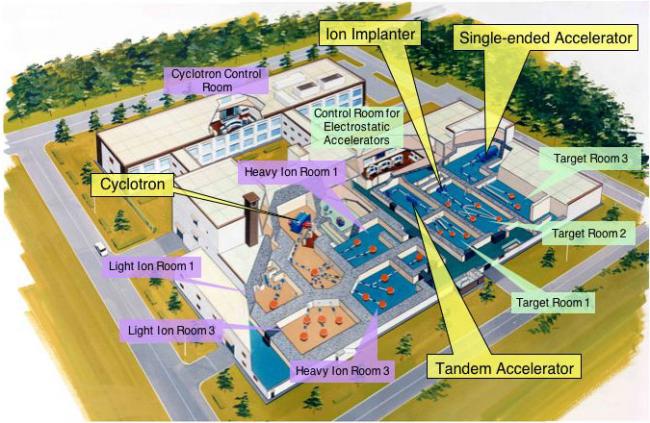
Sophisticated Techniques for Advanced Research using Ion Beams
Cocktail Beam Acceleration
It generally takes several hours to switch an ion species because of adjusting thecyclotron. However, switching the ion species in a short period of time has been required for efficient irradiation experiments. The cocktail beam acceleration technique makes this possible by simultaneously accelerating two or more different ion species which have a subequal ratio of atomic mass to electric charge, e.g. 20Ne7+ and 40Ar14+.
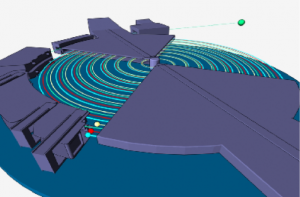
Core of Cyclotron
Large-Area Uniform Irradiation
An ion beam having a high-uniformity spatial distribution in a large area is formed by the sextupole and octupole focusing magnets. This technique enables us to perform simultaneous irradiation over a large-area sample which is more than 100 times larger than a usual beam size. The uniform beam is useful to the biological research and to the development of functional materials such as electrolyte membranes for fuel cells.
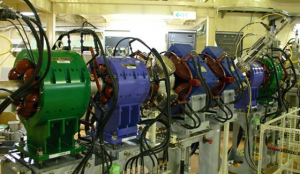
Sextupole and Octupole focusing magnets
Single-Ion Hit Technique
In order to demonstrate accuracy of the single-ion hit on an aimed area using this technique, a pattern of DARUMA was traced on a surface of CR-39 plastic, every ion track made by an ion is visible. This technique is useful to the analysis of a specific local area of biological cells and of a single event phenomenon in a semiconductor device.
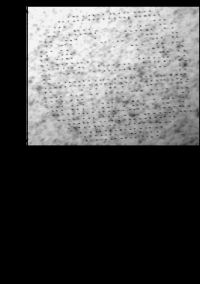
Hitting pattern of DARUMA
Micro-PIXE Analysis
Elements in a material emit their characteristic X-ray produced via excitations induced by ion beam irradiation. The Micro-PIXE (Particle Induced X-Ray Emission) analysis using the focused ion beam of 1µm-diameter or less enables us to obtain the elemental distribution in a biological cell, for example, by measuring the X-ray energy and the irradiated position.
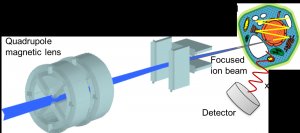
Micro-PIXE system
Swift Cluster Ion Beam
When cluster ions consisting of two or more atoms bombard solid material the characteristic physical phenomena takes place resulting from the collective behavior of the cluster constituent ions; it never appears under monatomic ion irradiation. The relatively small cluster ions up to C60+ are able to be accelerated by the tandem accelerator and the ion implanter at energies from keV to MeV.
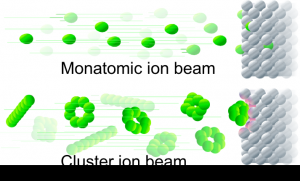
Image of a Cluster Ion Beam
Triple Ion Beam Irradiation
The triple ion beam technique was developed for research on the structural materials of nuclear reactors. The mechanism of material damages due to neutron collisions can be evaluated by simultaneous irradiation with three different ion beams other than neutrons.
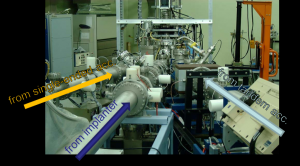
Triple Ion Beam Irradiation Chamber
Ion Accelerators
AVF CYCLOTRON
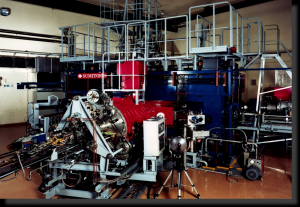
AVF Cyclotron
The AVF cyclotron provides various ions covering the high energy range. A cyclotron generally has instability in the magnetic field strength, which degrade beam quality. We accomplished very high stabilization in order to get formation of high energy heavy ion microbeam of 1 μm in diameter.
- K value : 110MeV
- Ion source : Multi-Cusp and ECR
Tandem Accelerator
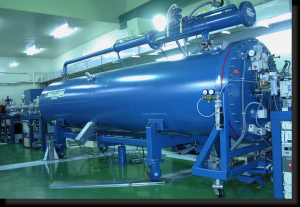
3MV Tandem Accelerator
The 3MV tandem accelerator mainly provides heavy ions covering the middle energy range. Several cluster ions of energy up to 6MeV are also avaible.
- Charging system : Pellet chain
- Acc. voltage : 0.4 ~ 3.0MV
- Acc. ion mass : 1 ~ 200 amu
- Ion source
Charge exchanging RF, Cs sputter
Ion Implanter
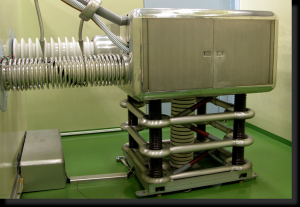
400kV Ion Implanter
The 400 kV ion implanter accelerates various ions covering the low energy range. Intense C60 ion beam (micro ampere level) is also available.
- Charging system : Cockcroft-Walton
- Acc. voltage : 10 ~ 400kV
- Acc. ion mass : 1 ~ 200 amu
- Ion source : Freeman type with sputter electrode
Single-ended Accelerator
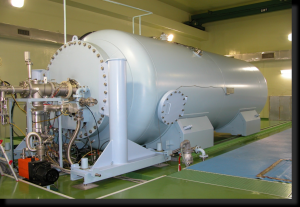
3MV Single-ended Accelerator
The 3MV single-ended accelerator was designed to achieve an extremely high voltage-stability in order to provide a stable submicron-microbeam. It provides ions p, d, and He. Additionally, It can accelerate electrons by changing the polarity of diodes in the acceleration voltage generating circuit.
- Charging system : Schenkel DC P.S.
- Acc. voltage : 0.4 ~ 3.0MV
- Acc. ion mass : H, d, He, and e
- Ion source : RF
